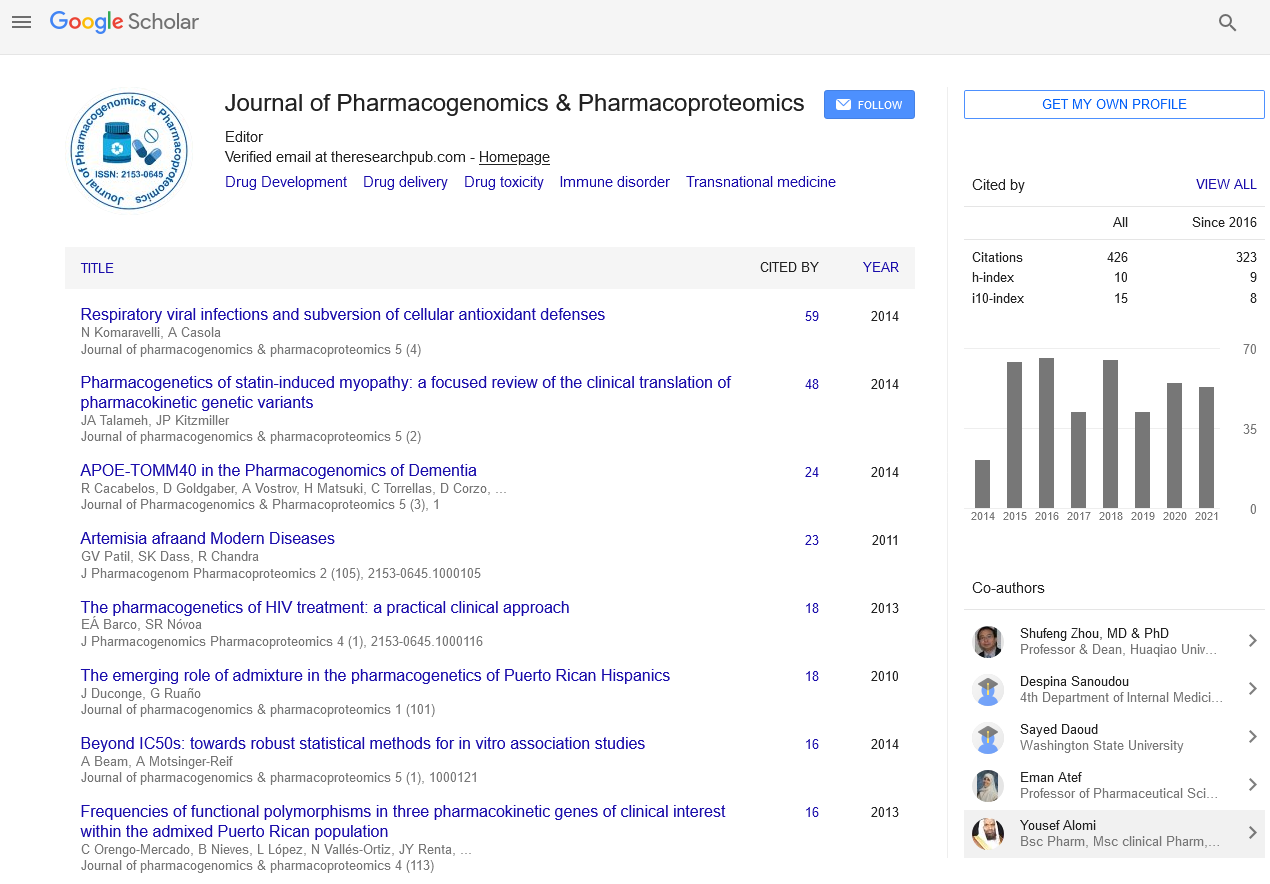Indexed In
- Open J Gate
- Genamics JournalSeek
- Academic Keys
- JournalTOCs
- ResearchBible
- Electronic Journals Library
- RefSeek
- Hamdard University
- EBSCO A-Z
- OCLC- WorldCat
- Proquest Summons
- SWB online catalog
- Virtual Library of Biology (vifabio)
- Publons
- MIAR
- Euro Pub
- Google Scholar
Useful Links
Share This Page
Journal Flyer

Open Access Journals
- Agri and Aquaculture
- Biochemistry
- Bioinformatics & Systems Biology
- Business & Management
- Chemistry
- Clinical Sciences
- Engineering
- Food & Nutrition
- General Science
- Genetics & Molecular Biology
- Immunology & Microbiology
- Medical Sciences
- Neuroscience & Psychology
- Nursing & Health Care
- Pharmaceutical Sciences
Abstract
Pharmacogenomics of CYP3A5 Polymorphism: Predicting Dose-adjusted Trough Levels of Tacrolimus in South Indian Renal Transplant Patients
Sarasamma S, Gracious N, Nair SS and Radhakrishnan R
Tacrolimus is a potent immunosuppressant clinically used for the long term treatment of antirejection of transplanted organs in liver and kidney transplant recipients although dose optimization is often poorly managed. So far, no study has been carried out in the South Indian kidney transplant patients. The objective of this study was to evaluate the potential influence of a functional polymorphism in CYP3A5*3 gene on tacrolimus physiological availability/dose ratio in South Indian renal transplant patients. Twenty five renal transplant recipients receiving tacrolimus were enrolled in this study. Their body weight, drug dosage, and therapeutic concentration of tacrolimus were observed. All patients were on a standard immunosuppressive regime of tacrolimus-mycophenolate mofetil (Immunosuppressant) along with steroids at a starting dose of 0.1 mg/kg/day tacrolimus. CYP3A5 genotyping was performed by PCR followed with RFLP. Confirmation of RFLP analysis and variation in the nucleotide sequence of CYP3A5*3 gene were determined by direct sequencing using a validated automated genetic analyzer. A significant association was found between tacrolimus dose/kg/d and CYP3A5 gene (A6986G) polymorphism in the study population. The CYP3A5 *1/*1,*1/*3 and *3/*3 genotypes were detected in 5 (20%), 5 (20%) and 15 (60%) of the 25 graft recipients, respectively. CYP3A5*3 genotypes were found to be a good predictor of tacrolimus Level/Dose (L/D) ratio in kidney transplant recipients. Significantly higher L/D ratios were observed among non-expressors 9.483 ng/mL (range 4.5-14.1 ng/mL) as compared with the expressors 5.154 ng/mL (range 4.42-6.5 ng/mL) of CYP3A5. Biopsy Proven Acute Rejection (BPAR) episodes were significantly higher in CYP3A5*1 homozygotes compared to patients with CYP3A5*1/*3 and CYP3A5*3/*3 genotypes (40% vs. 20% and 13%, respectively). The dosenormalized tacrolimus concentration (ng/mL/mg/Kg) was significantly lower in patients having CYP3A5*1/*3 polymorphism. This is the first study to extensively determine the effect of CYP3A5*3 genetic polymorphism on tacrolimus pharmacokinetics in South Indian renal transplant recipients, and this study also showed that the majority of our patients carry mutant allele A6986G in the CYP3A5*3 gene. Identification of CYP3A5 polymorphism prior to transplantation is important for selecting the appropriate initial dosage of tacrolimus for each patient.


